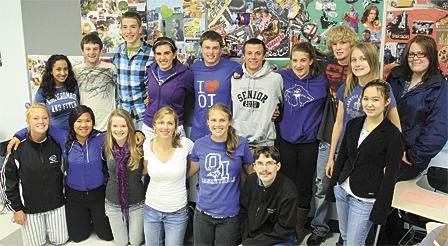It’s a culmination of their final year of learning, and a reflection of their personal interests.
The Orcas High School graduating class will present its senior projects before an audience of community members, fellow students and faculty on June 8.
Each senior met with teachers Kathleen Collister and Val Hellar to discuss their project idea last fall.
“I always say, what do you feel passionate about?” said Hellar. “You need a project that can sustain your interest for several months. And they can’t just do something they’ve done before; they have to prove some sort of a learning stretch that reflects personal growth. We also try to scale back if they’re just too crazy. Sometimes they have to redirect; they find out a project can’t be completed and they have to change their idea.”
The students specialized their studies in an area of personal interest, and using that knowledge they built something or shared their learning with others by teaching classes or conducting assemblies.
Many focused on environmental and agricultural concerns. Willie Eagan created a water wheel to generate hydro power. Emily Diepenbrock designed and created reusable mesh produce and grocery bags. Stephanie Shaw tested soil from various farms and studied environmentally sound farming practices. Jonathan Carrick cultivated plants using hydroponics. Berry Sharp studied bioremediation and bioaugmentation in stewarding ecosystems. Samantha Tidwell created a guidebook of local, edible plants. Tyler Nigretto remodeled an old shed into a livable space. Hannah North created a cold frame using re-cycled materials. and Taylor Diepenbrock worked with an environmental organization in Haiti.
Others applied themselves to the arts, many with a therapeutic angle.
Tess King created a website showcasing artwork by Orcas Island students. Jeanie Tran studied art therapy and taught art classes. Tika Thorson taught a photography class to island 4-H kids and studied media and body image.
Bobbi Lowry learned to play the piano and put on a concert, and Alaina Vedder recorded her own music album and studied media, role models and teen violence.
Josh Inch built a bench using sustainable wood. Terri Vinson sewed a traditional Korean dress, or hanbok. Lanie Padbury created a unique quilt for a wounded war veteran and studied new treatments for post-traumatic stress disorder.
Others simply followed their hearts into territory unknown.
Molly Staub studied therapeutic animals and autism, conducting educational assemblies and fundraising.
Alison O’Toole collected stories from local elders for the Orcas Island Historical Museum’s Journey Stories exhibit.
Jessica Laursen created a Spanish lesson video for primary students and Erik Sherman taught a class on drug awareness.
Daniel Janssen taught training strategies to a class of athletes. Nick Van Maren trained with local firefighters to receive his firefighter certification and studied commercial logging and forest fires.
And Henri Bredouw taught himself magic, with the help of nine-year-old Matthew Laslo-White. Bredouw put on a show of tricks and illusions for the first grade class.
“He came back looking like he’d been in a war zone,” said Hellar.
She said the assignment is an opportunity for the kids to discover something new about themselves, and has significant career-planning value: sometimes the kids end up redirecting from a career course they were pondering.
For example, a student might find out he doesn’t necessarily want to work with first-graders.
The kids also experienced non-profit fundraising, many donating proceeds from their projects to causes like Haiti or the Nature Conservancy.
“I always find (the projects) fascinating in some way,” Hellar said.




